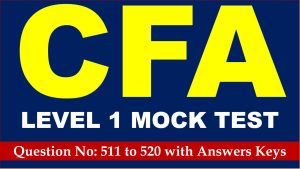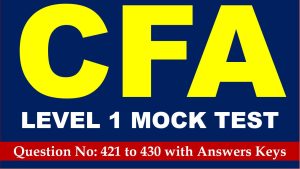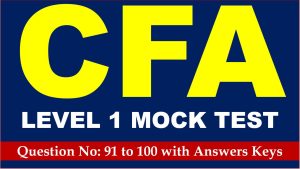Hi CFA Aspirants, welcome to AKVTutorials. Are you preparing for CFA Level 1, 2, 3 exams for making a career in CFA (Charted Financial Analyst). According to CFA Wikipedia, CFA The Chartered Financial Analyst (CFA) program is a postgraduate professional certification offered internationally by the American-based CFA Institute. A candidate who successfully completes the program and meets other professional requirements is awarded the “CFA charter” and becomes a “CFA charter holder”. Therefore, you need CFA Study Notes and Free CFA Level 1 Sample Quiz 20 Questions Answer Keys AMBIPi.
In this article, you will get Free CFA Level 1 Mock Exam Practice Questions.
Free CFA Level 1 Mock Practice Exam Questions Bank
Free CFA Level 1 Practice Question No: 191:
Which of the following statements is NOT true relating to Standard IV (B.3) – Fair Dealing?
Option A : This standard covers the conduct of two groups: those who prepare recommendations and those who take investment action.
Option B : Members shall deal equally and objectively with all clients.
Option C : Only through the fair treatment of all parties can the investment management profession maintain the confidence of the investing public.
Option D : None of these answers.
Option E :This standard covers investment action such as general purchases, new issues, or secondary offerings.
Show/Hide Answer
Option B :
The operative ward is “fairly,” not “equally.” The term “fairly” implies that the member must take care not to discriminate against any customers or clients when disseminating investment recommendations. Members could not possibly reach all clients “equally” (i.e., simultaneously). In addition, each client has unique needs, investment criteria and investment objectives.
CFA Level 1 Exam Question No: 192:
Grazelle Garbo has decided to change the recommendation on one of the firms she is following from hold to buy. She has communicated her research report to her senior manager, who is reviewing it. If the recommendation passes muster, it will be released three days from now. In the meanwhile, Grazelle has decided to follow her research and purchase the stock for several of her clients’ accounts for which the stock is an appropriate investment and for which she has discretionary investment powers. In the course of the luncheon meeting that same day, she mentioned that she had bought the stocks for some client accounts to one of her prospective clients and described her research which caused her to change her recommendation. Grazelle has
I. violated Standard IV (B.3) – Fair Dealing – by revealing the change in recommendation.
II. violated Standard IV (B.5) – Preservation of Confidentiality – by revealing the information about stock purchase.
III. did not violate the Ethics code.
Option A: I and II only.
Option B: II only.
Option C: III only.
Option D: I only.
Show/Hide Answer
Option D : I only.
Since Grazelle has not revealed any information about the specific client accounts or any confidential information, she is not in violation of Standard IV (B.5) – Preservation of Confidentiality. However, by revealing the information on the change in recommendation prematurely to one of her prospective clients, she has violated Standard IV (B.3) – Fair Dealing. The information is potentially quite valuable and giving to one client before another in a partisan fashion is a violation of the AIM code of Ethics.
Free CFA Level 1 Mock Exam Question No: 193:
Which of the following AIM Standards pertains to the use of professional designation
Option A: II (A).
Option B: І.
Option C: III (A).
Option D: III (B).
Show/Hide Answer
Option A : II (A).
Standard II (A) – Use of Professional Designation – states the responsibility of AIM members, CFA charterholders and candidates for the CFA designation to use their professional designations, or their candidacies for the designation, properly and in a manner that does not mislead the investing public or others.
CFA Level 1 Free Practice Question No: 194:
In reference to AIMR-PPS, which of the following is/are true?
I. The PPS are explicitly incorporated in the AIM Code of Ethics and Standards of Professional Conduct.
II. In case of system incompatibilities, the firm can claim compliance for only those assets that are measured and monitored on compatible systems.
III. Plan sponsors, consultants and software vendors cannot claim compliance with the PPS; they can only endorse or require their clients to be in compliance.
Option A: I, II and III.
Option B: III only.
Option C: II and III only.
Option D: I only.
Show/Hide Answer
Option B : III only.
The PPS are an adjunct to the AIMR Code of Ethics and Standards of Professional Conduct and not explicitly incorporated in that framework. Compliance with PS is voluntary, not required.
Free CFA Practice Question No: 195:
Standard IV (B.2) deals with ______.
Option A: compensation.
Option B: fair dealing.
Option C: soft dollars.
Option D: competition.
Option E: none of these answers.
Option F: suitability.
Option G: proxy voting.
Option F: disclosure of conflicts.
Show/Hide Answer
Option F : disclosure of conflicts.
Standard IV (B.2) deals with the appropriateness and suitability of investment recommendations for each portfolio or client.
CFA Level 1 Sample Question No: 196:
The procedures for compliance with Standard IV (B.8), Disclosure of Referral Fees, recommend that you disclose all referral agreements __________.
Option A: at least orally.
Option B: any of these answers.
Option C: orally or in writing.
Option D: in writing.
Show/Hide Answer
Option D : in writing.
Under Standard IV (B.8), members should disclose all agreements in order to be in compliance. Members should disclose, in writing, the existence and terms of any referral agreement to any client or prospective client as soon as the member learns that the client or prospective client has been referred by a firm receiving a referral fee.
Free CFA Level 1 Quiz Question NO: 197:
When taking on a new affiliation while working for his present employer, a member should:
Option A: notify his employer in writing and obtain written consent.
Option B: notify any prospective affiliation of his present employer.
Option C: not render services to a new client until the client gives consent in writing.
Option D: all of these answers are correct.
Show/Hide Answer
Option D : all of these answers are correct.
The procedures for compliance with Standard III (B) state that members should not render services until receiving written consent from their employer to all of the terms of the arrangement, after having provided written statements describing the types of services to be rendered to independent affiliations. A member should also disclose to prospective clients the identity of the member’s employer and clarify that the member is performing independently of the employer. The member should not render services until the client gives consent in writing indicating that the client has read and understood the member’s written disclosure statement.
Free CFA Level 1 Quiz Question NO: 198:
Relationships with and Responsibilities to the Profession are dealt with under:
Option A: Standard II.
Option B: Standard IV.
Option C: None of these answers.
Option D: Standard I.
Option E: Standard V.
Option F: Standard III.
Show/Hide Answer
Option A : Standard II.
Relationships with and Responsibilities to the Profession are dealt with under Standard II.
Free CFA Practice Question No: 199:
Which AIMR standard states that members must inform employers of their duty to comply with the Code and Standards and must deliver a copy to their employers?
Option A: IX.
Option B: IV.
Option C: III A.
Option D: IIA.
Show/Hide Answer
Option C : III A.
Standard III (A) Obligation to Inform Employer of Code and Standards states: Members shall: “(1) Inform their employer in writing, through their direct supervisor, that they are obligated to comply with the Code and Standards and are subject to disciplinary sanctions for violations thereof, and (2) Deliver a copy of the Code and Standards to their employer if the employer does not have a copy.’
CFA Mock Exam Free Question No: 200:
When formulating an investment policy for a client, which of the following falls under the category “client identification?”
Option A: risk tolerance.
Option B: time horizon.
Option C: expected cash flows.
Option D: the existence of separate beneficiaries.
Option E: none of these answers.
Show/Hide Answer
Option D : the existence of separate beneficiaries.
“Client identification” requires that the existence of separate beneficiaries be considered. Risk tolerance is considered under “investor objectives.” Time horizon is considered under “investor constraints.’



